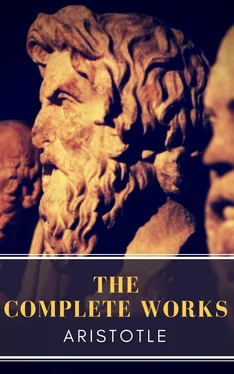Aristotle Aristotle - Aristotle - The Complete Works
Здесь есть возможность читать онлайн «Aristotle Aristotle - Aristotle - The Complete Works» — ознакомительный отрывок электронной книги совершенно бесплатно, а после прочтения отрывка купить полную версию. В некоторых случаях можно слушать аудио, скачать через торрент в формате fb2 и присутствует краткое содержание. Жанр: unrecognised, на английском языке. Описание произведения, (предисловие) а так же отзывы посетителей доступны на портале библиотеки ЛибКат.
- Название:Aristotle: The Complete Works
- Автор:
- Жанр:
- Год:неизвестен
- ISBN:нет данных
- Рейтинг книги:3 / 5. Голосов: 1
-
Избранное:Добавить в избранное
- Отзывы:
-
Ваша оценка:
- 60
- 1
- 2
- 3
- 4
- 5
Aristotle: The Complete Works: краткое содержание, описание и аннотация
Предлагаем к чтению аннотацию, описание, краткое содержание или предисловие (зависит от того, что написал сам автор книги «Aristotle: The Complete Works»). Если вы не нашли необходимую информацию о книге — напишите в комментариях, мы постараемся отыскать её.
This edition has been professionally formatted and contains several tables of contents. The first table of contents (at the very beginning of the ebook) lists the titles of all novels included in this volume. By clicking on one of those titles you will be redirected to the beginning of that work, where you'll find a new TOC that lists all the chapters and sub-chapters of that specific work.
Aristotle: The Complete Works — читать онлайн ознакомительный отрывок
Ниже представлен текст книги, разбитый по страницам. Система сохранения места последней прочитанной страницы, позволяет с удобством читать онлайн бесплатно книгу «Aristotle: The Complete Works», без необходимости каждый раз заново искать на чём Вы остановились. Поставьте закладку, и сможете в любой момент перейти на страницу, на которой закончили чтение.
Интервал:
Закладка:
When, then, is there a difference of species? Is an attribute specifically different if the subject is different while the attribute is the same, or must the attribute itself be different as well? And how are we to define the limits of a species? What will enable us to decide that particular instances of whiteness or sweetness are the same or different? Is it enough that it appears different in one subject from what appears in another? Or must there be no sameness at all? And further, where alteration is in question, how is one alteration to be of equal velocity with another? One person may be cured quickly and another slowly, and cures may also be simultaneous: so that, recovery of health being an alteration, we have here alterations of equal velocity, since each alteration occupies an equal time. But what alteration? We cannot here speak of an ‘equal’ alteration: what corresponds in the category of quality to equality in the category of quantity is ‘likeness’. However, let us say that there is equal velocity where the same change is accomplished in an equal time. Are we, then, to find the commensurability in the subject of the affection or in the affection itself? In the case that we have just been considering it is the fact that health is one and the same that enables us to arrive at the conclusion that the one alteration is neither more nor less than the other, but that both are alike. If on the other hand the affection is different in the two cases, e.g. when the alterations take the form of becoming white and becoming healthy respectively, here there is no sameness or equality or likeness inasmuch as the difference in the affections at once makes the alterations specifically different, and there is no unity of alteration any more than there would be unity of locomotion under like conditions. So we must find out how many species there are of alteration and of locomotion respectively. Now if the things that are in motion-that is to say, the things to which the motions belong essentially and not accidentally-differ specifically, then their respective motions will also differ specifically: if on the other hand they differ generically or numerically, the motions also will differ generically or numerically as the case may be. But there still remains the question whether, supposing that two alterations are of equal velocity, we ought to look for this equality in the sameness (or likeness) of the affections, or in the things altered, to see e.g. whether a certain quantity of each has become white. Or ought we not rather to look for it in both? That is to say, the alterations are the same or different according as the affections are the same or different, while they are equal or unequal according as the things altered are equal or unequal.
And now we must consider the same question in the case of becoming and perishing: how is one becoming of equal velocity with another? They are of equal velocity if in an equal time there are produced two things that are the same and specifically inseparable, e.g. two men (not merely generically inseparable as e.g. two animals). Similarly one is quicker than the other if in an equal time the product is different in the two cases. I state it thus because we have no pair of terms that will convey this ‘difference’ in the way in which unlikeness is conveyed. If we adopt the theory that it is number that constitutes being, we may indeed speak of a ‘greater number’ and a ‘lesser number’ within the same species, but there is no common term that will include both relations, nor are there terms to express each of them separately in the same way as we indicate a higher degree or preponderance of an affection by ‘more’, of a quantity by ‘greater.’
<
div id="section61" class="section" title="5">
5
Now since wherever there is a movent, its motion always acts upon something, is always in something, and always extends to something (by ‘is always in something’ I mean that it occupies a time: and by ‘extends to something’ I mean that it involves the traversing of a certain amount of distance: for at any moment when a thing is causing motion, it also has caused motion, so that there must always be a certain amount of distance that has been traversed and a certain amount of time that has been occupied). then, A the movement have moved B a distance G in a time D, then in the same time the same force A will move 1/2B twice the distance G, and in 1/2D it will move 1/2B the whole distance for G: thus the rules of proportion will be observed. Again if a given force move a given weight a certain distance in a certain time and half the distance in half the time, half the motive power will move half the weight the same distance in the same time. Let E represent half the motive power A and Z half the weight B: then the ratio between the motive power and the weight in the one case is similar and proportionate to the ratio in the other, so that each force will cause the same distance to be traversed in the same time. But if E move Z a distance G in a time D, it does not necessarily follow that E can move twice Z half the distance G in the same time. If, then, A move B a distance G in a time D, it does not follow that E, being half of A, will in the time D or in any fraction of it cause B to traverse a part of G the ratio between which and the whole of G is proportionate to that between A and E (whatever fraction of AE may be): in fact it might well be that it will cause no motion at all; for it does not follow that, if a given motive power causes a certain amount of motion, half that power will cause motion either of any particular amount or in any length of time: otherwise one man might move a ship, since both the motive power of the ship-haulers and the distance that they all cause the ship to traverse are divisible into as many parts as there are men. Hence Zeno’s reasoning is false when he argues that there is no part of the millet that does not make a sound: for there is no reason why any such part should not in any length of time fail to move the air that the whole bushel moves in falling. In fact it does not of itself move even such a quantity of the air as it would move if this part were by itself: for no part even exists otherwise than potentially.
If on the other hand we have two forces each of which separately moves one of two weights a given distance in a given time, then the forces in combination will move the combined weights an equal distance in an equal time: for in this case the rules of proportion apply.
Then does this hold good of alteration and of increase also? Surely it does, for in any given case we have a definite thing that cause increase and a definite thing that suffers increase, and the one causes and the other suffers a certain amount of increase in a certain amount of time. Similarly we have a definite thing that causes alteration and a definite thing that undergoes alteration, and a certain amount, or rather degree, of alteration is completed in a certain amount of time: thus in twice as much time twice as much alteration will be completed and conversely twice as much alteration will occupy twice as much time: and the alteration of half of its object will occupy half as much time and in half as much time half of the object will be altered: or again, in the same amount of time it will be altered twice as much.
On the other hand if that which causes alteration or increase causes a certain amount of increase or alteration respectively in a certain amount of time, it does not necessarily follow that half the force will occupy twice the time in altering or increasing the object, or that in twice the time the alteration or increase will be completed by it: it may happen that there will be no alteration or increase at all, the case being the same as with the weight.
Конец ознакомительного фрагмента.
Интервал:
Закладка:
Похожие книги на «Aristotle: The Complete Works»
Представляем Вашему вниманию похожие книги на «Aristotle: The Complete Works» списком для выбора. Мы отобрали схожую по названию и смыслу литературу в надежде предоставить читателям больше вариантов отыскать новые, интересные, ещё непрочитанные произведения.
Обсуждение, отзывы о книге «Aristotle: The Complete Works» и просто собственные мнения читателей. Оставьте ваши комментарии, напишите, что Вы думаете о произведении, его смысле или главных героях. Укажите что конкретно понравилось, а что нет, и почему Вы так считаете.












